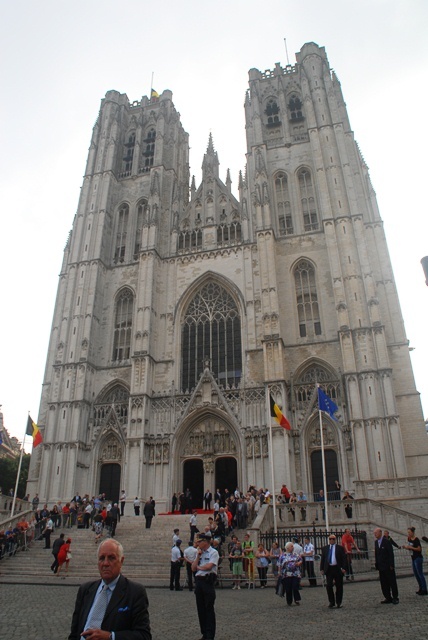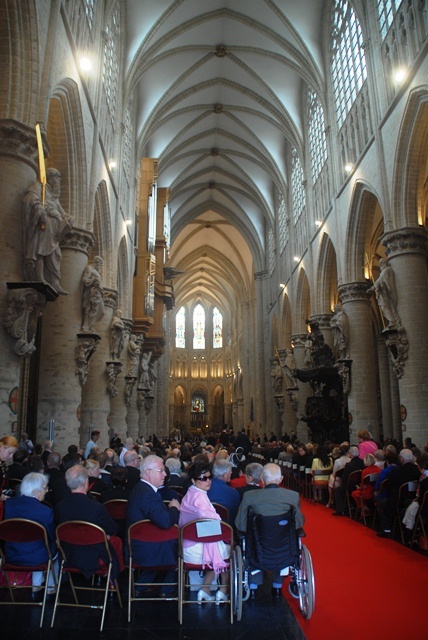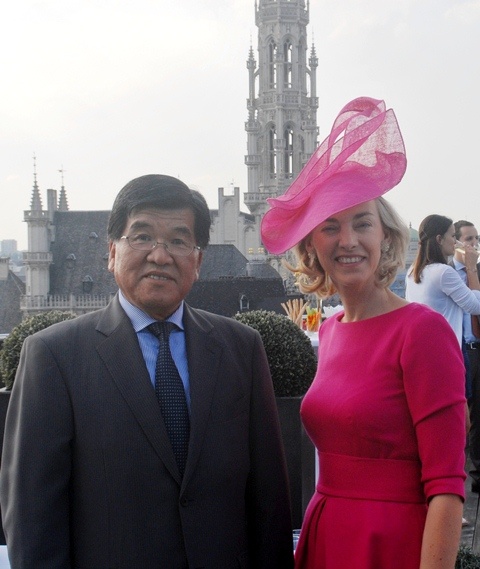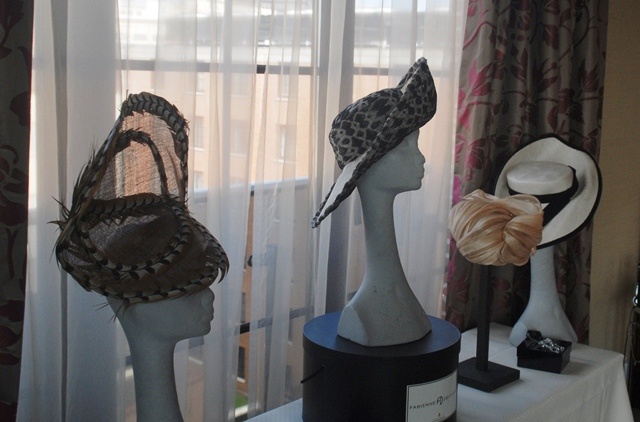Official notice to return home in mid-summer,
A service in Belgium of short duration (No.59)
In about one month and a half my work in Belgium will come to an end. Today I have received the order to return to Japan from the Minister of Foreign Affairs, and so within 40 days I have to leave Belgium. As I was appointed as the new ambassador in October 2012, it was a short tenure in Belgium of less than two years. However, as a Japanese Ambassador residing in many countries, I belong to the group with the longest state of service, having lived a diplomat’s life for more than 41 years, and thus now the time has come to pass the torch to the younger people. I would like to express my thanks to the great number of people that have read with pleasure these “Chats”. Because the blog appeared on the Embassy’s homepage in Japanese and English immediately after my arrival, I have been able to attract a lot of readers. I think have managed to give a short peek inside the daily life of the Japanese Ambassador here in Belgium, and I am proud that I was able to show how attractive the country called Belgium is, and to shed a light on the relations between Japan and Belgium. Of course, in my position as ambassador I have to refrain from showing an openhearted opinion on all matters, and I was not able to touch upon the delicate part of my diplomatic activities due to diplomatic secrecy. Nevertheless, in spite of the limitations, I wrote and updated this blog as often and as detailed as possible in order to let you get acquainted with the daily activities of an ambassador. And so, in the past one year and nine months I have been tapping away at my home computer whenever I had a free evening in the week or in the weekend, and I surprised even myself when I reached “No. 59”. I plan to update it 2 or 3 more times by the time I leave Brussels, because up until the very end I would like to stay in contact with my readers.
<Celebrating King Philippe’s first anniversary as a king on the Belgian Independence Day >
 Yesterday the religious event “Te Deum”, celebrating Independence Day, was held in the Cathedral of Saint-Michel in the center of Brussels, and as a member of the diplomatic corps I was present. Their Majesties King Philippe and Queen Mathilde and their children, the 4 young princes and princesses were seated to the left of the altar on special seats, Prime Minister Di Rupo and members of the federal cabinet were lined-up to the right of the altar. Every time also many representatives of the general public attend. Because it was exactly one year to the day that His Majesty King Philippe ascended the throne, it became a “Te Deum” celebrating the first anniversary of his reign. yomoyama_059_tedeum2 Yesterday the religious event “Te Deum”, celebrating Independence Day, was held in the Cathedral of Saint-Michel in the center of Brussels, and as a member of the diplomatic corps I was present. Their Majesties King Philippe and Queen Mathilde and their children, the 4 young princes and princesses were seated to the left of the altar on special seats, Prime Minister Di Rupo and members of the federal cabinet were lined-up to the right of the altar. Every time also many representatives of the general public attend. Because it was exactly one year to the day that His Majesty King Philippe ascended the throne, it became a “Te Deum” celebrating the first anniversary of his reign. yomoyama_059_tedeum2 This event is held twice a year, on Independence Day, and on the 15th of November, King’s Day. It always takes place in the Cathedral of Saint-Michel which is affiliated with the royal household (see “Chat of the Ambassador No. 2” for more detailed information). It is a short event of about 40 minutes but it is amazing how one gets into a solemn mood. After the “Te Deum”, I moved to the Egmont Palace near the Sablon where I attended a reception held by both the presidents of the Senate and the Chamber of Representatives, and the Minister of Foreign Affairs. Besides the diplomatic corps, also officials of the Belgian parliament were invited, so it became an opportunity for me to greet several friends from the parliament. The annual military parade was held in the afternoon in front of the Palace but a colleague from the Embassy attended on my behalf. This event is held twice a year, on Independence Day, and on the 15th of November, King’s Day. It always takes place in the Cathedral of Saint-Michel which is affiliated with the royal household (see “Chat of the Ambassador No. 2” for more detailed information). It is a short event of about 40 minutes but it is amazing how one gets into a solemn mood. After the “Te Deum”, I moved to the Egmont Palace near the Sablon where I attended a reception held by both the presidents of the Senate and the Chamber of Representatives, and the Minister of Foreign Affairs. Besides the diplomatic corps, also officials of the Belgian parliament were invited, so it became an opportunity for me to greet several friends from the parliament. The annual military parade was held in the afternoon in front of the Palace but a colleague from the Embassy attended on my behalf.
<VOKA and UWE>
In the past ten days I have met with Mr. Michel Delbaere, President of VOKA, which is the Flemish business organization and with his Walloon counterpart, Mr. Jean-François Heris, President of UWE, the Walloon business organization. Both organizations are described in “Ambassador’s Chat No. 55”. In a country as Belgium, where the national circumstances are such that the country is divided in a Dutch-speaking and a French-speaking region under a federal system, the influence of both regional business organizations is very large. In my meeting with them I asked when and how we were going to hold the “Promoting Investment and Trade Seminar” (Tokyo) by Japanese and Belgian businessmen, which was agreed upon last May during the Japan – Belgium summit. I got a lot of valuable suggestions from the two people at the top of both regional business organizations.
As it stands, Mr. Heris, the president of UWE, happens to be also CEO of AGC Glass Europe, a branch of the Japanese Asahi Glass Company. This time, I met with CEO Heris in the company’s new building in Louvain-la-Neuve, where they moved to just last year in November. It’s a unique glass-surfaced building, appropriate for a glass company. The three- story building, standing on a square surface of 100m by 100m, is made out of special glass excelling in lighting functionality; its architecture is green and sustainable with solar panels on the roof and moreover all employees sit at their desk in a large hall, with enough space provided for everyone. What surprised me was the fact that CEO Heris didn’t have his own office, but was working in the same large hall as the other employees. Although in the workplace of Japanese companies the “large working floor-method” is common, I have never heard of a large working floor for the top of the enterprise. Heris explained that: “If you want to introduce open workspaces in a Europe accustomed to individual rooms, it is necessary for the CEO to set an example worth following”. The two female secretaries seated next to the CEO showed a subtle expression whilst listening on the side to the explanation by the CEO; I wonder what they were thinking….
<A Belgium company selling large professional laundry machines all over the world>
 Last week I visited Lapauw International, located just outside the city of Kortrijk, and I was allowed to visit the site where large laundry machines for professional use are produced. I got to know CEO Mr. D’heygere by chance and the fact that I heard they have Japanese customers brought me to visit the company. We all know our washing machines at home, but we have few occasions to see washing machines for professional use and it’s worth to have a look at that state-of-the-art technology. Their customers are specialized enterprises handling laundry such as large amounts of sheets and towels from hospitals and hotels on a daily basis and the laundry machines are sold in combination with another large machine for ironing. They have also a device that can clean and sterilize a hospital bed in its whole. yomoyama_059_lapauw2They explained that the machines require a strong structure so special metals are used in order to continually withstand temperatures of 160°C and a gravity pull of 300G caused by spinning turbines. Their products are sold all over the world and they seem to be even used in the White House and the Kremlin. In the case of Japan, they not only sell their own products but they are also in charge of selling similar products made by the Japanese company TOTO as sales agencies all around the world. CEO D’heygere was brought up in a family that manufactured and sold tobacco, but thinking that tobacco harms one’s health, he sold all factories and bought Lapauw four years ago. The Gryson tobacco factory on the outskirts of Kortrijk belonged to the D’heygere family as well but two years ago it came in the hands of a Japanese company (JTI) via another company. The Lapauw Company seems to have been established just after the Second World War upon request from local hospitals having to accommodate a large number of injured, generating a huge amount of laundry. Today about 100 employees are working in the large factory, taking orders from customers around the world and making products according to their needs. The company shows a strong presence in an industry niche with advanced technologies and seemingly with a Belgian attitude…. Last week I visited Lapauw International, located just outside the city of Kortrijk, and I was allowed to visit the site where large laundry machines for professional use are produced. I got to know CEO Mr. D’heygere by chance and the fact that I heard they have Japanese customers brought me to visit the company. We all know our washing machines at home, but we have few occasions to see washing machines for professional use and it’s worth to have a look at that state-of-the-art technology. Their customers are specialized enterprises handling laundry such as large amounts of sheets and towels from hospitals and hotels on a daily basis and the laundry machines are sold in combination with another large machine for ironing. They have also a device that can clean and sterilize a hospital bed in its whole. yomoyama_059_lapauw2They explained that the machines require a strong structure so special metals are used in order to continually withstand temperatures of 160°C and a gravity pull of 300G caused by spinning turbines. Their products are sold all over the world and they seem to be even used in the White House and the Kremlin. In the case of Japan, they not only sell their own products but they are also in charge of selling similar products made by the Japanese company TOTO as sales agencies all around the world. CEO D’heygere was brought up in a family that manufactured and sold tobacco, but thinking that tobacco harms one’s health, he sold all factories and bought Lapauw four years ago. The Gryson tobacco factory on the outskirts of Kortrijk belonged to the D’heygere family as well but two years ago it came in the hands of a Japanese company (JTI) via another company. The Lapauw Company seems to have been established just after the Second World War upon request from local hospitals having to accommodate a large number of injured, generating a huge amount of laundry. Today about 100 employees are working in the large factory, taking orders from customers around the world and making products according to their needs. The company shows a strong presence in an industry niche with advanced technologies and seemingly with a Belgian attitude….
<Hats designed by Ms. Delvigne for the ladies of Royal Families>
 The hats worn by the Queens and Princesses of the European royal families are very fashionable and specially shaped. It is well known among fashion loving women that it is the Belgian designer Ms. Fabienne Delvigne who designed many of those hats. Out of curiosity, I visited a small exposition by her in a hotel in Brussels, intended for the diplomatic corps. At the venue there were photo panels of King Philippe and Queen Mathilde, flaunting the fact that it was an event of a royal warrant holder. The hats worn by the Queens and Princesses of the European royal families are very fashionable and specially shaped. It is well known among fashion loving women that it is the Belgian designer Ms. Fabienne Delvigne who designed many of those hats. Out of curiosity, I visited a small exposition by her in a hotel in Brussels, intended for the diplomatic corps. At the venue there were photo panels of King Philippe and Queen Mathilde, flaunting the fact that it was an event of a royal warrant holder.  Her career as a professional designer dates back to 1986, when she achieved successes in the haute couture world of Chanel, Armani, Yves Saint Laurent and the likes. Today, while establishing her own brand, she also provides her work to Natan, a brand connected to the Belgian royal family. I had an opportunity to talk to her at the venue and she told me that once she gave a presentation about design to Japanese and Belgian ladies at the Japanese ambassador’s residence. Because her work is not only worn by the Belgian royal family, but is also often worn by the Swedish, Dutch and Luxemburg royal households, I would like to pay more attention to the hats too when royal family events are broadcasted on television. Her career as a professional designer dates back to 1986, when she achieved successes in the haute couture world of Chanel, Armani, Yves Saint Laurent and the likes. Today, while establishing her own brand, she also provides her work to Natan, a brand connected to the Belgian royal family. I had an opportunity to talk to her at the venue and she told me that once she gave a presentation about design to Japanese and Belgian ladies at the Japanese ambassador’s residence. Because her work is not only worn by the Belgian royal family, but is also often worn by the Swedish, Dutch and Luxemburg royal households, I would like to pay more attention to the hats too when royal family events are broadcasted on television.
<Japan through the eyes of ambassador Branders>
Beginning of this month I was invited to dinner at the home of Mr. and Mrs. Branders, who was Ambassador of Belgium to Japan between 2002 and 2006, and we talked about their memories of their stay in Japan. This dinner party was also attended by a Belgian business man and his wife, who were stationed in Japan for six years during the same period as Ambassador Branders and I was relieved that they all seemed to have greatly enjoyed their stay in Japan. Ambassador Branders retired from the Foreign Office one year ago, but as his son is working as a young diplomat at the Belgian Embassy in Tokyo, he still has the occasion to go to Japan from time to time. They had good memories of visiting the countryside, staying at a ryokan and interacting with the people there. I listened with great interest to their stories of being at a loss because there was no chair to sit in the room of the ryokan and of longing for Western food. It surprised me that they loved Japanese food like “Natto (fermented soybeans)” (because the flavor is similar to cheese) and “Mochi” (Japanese rice cake) but that they didn’t like “Oden”, which is sold over the counter next to the cash register in convenience stores. I heard they often watched Japanese movies and particularly appreciated “Tampopo” (1985) and “Okuribito (“Departures” in English title)” (2008), which seems to be common among foreigners. At the same time of the dinner the World Cup quarterfinal of Belgium against Argentina was taking place, but unfortunately Belgium lost, so it was a pity we could not get all excited about soccer.
|